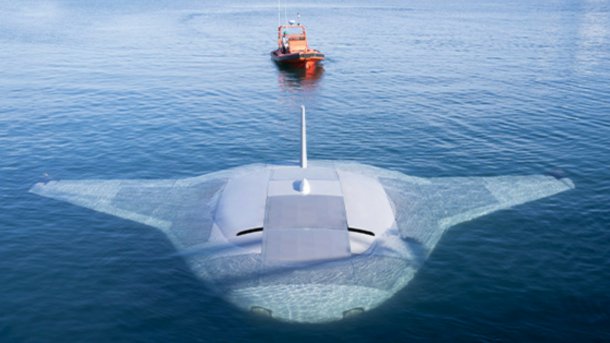US military tests prototype of giant stingray underwater drone
Thanks to its streamlined design, the Manta Ray underwater drone should be as energy-efficient as possible. The energy is to be obtained from the oceans.

The Manta Ray underwater drone is quite large. Here during preparatory work for initial tests.
(Bild: Northrop Grumman)
A giant underwater drone in the shape of a Manta Ray, a stingray that is capable of swimming in oceans for very long periods of time without refueling, has completed initial tests on the coast of the US state of California. This was announced by the Defense Advanced Research Projects Agency (DARPA), the US military's research facility, on Wednesday. The purpose of the tests was to demonstrate buoyancy and to try out different propulsion and control concepts.
However, DARPA and the defense contractor Northrop Grumman are not providing any technical data on the Manta Ray underwater drone. It is estimated to be around 6 meters long and have a wingspan of around 10 meters. The weight is not known. However, Manta Ray is said to contain cargo bays of various sizes to accommodate payloads.
Generating energy from the ocean
The Manta Ray project was launched five years ago. The aim is to build an underwater drone that can travel highly autonomously in the oceans. The focus is on an extremely long range without refueling or recharging. This is to be achieved, among other things, by using the movement of the ocean to generate energy so that the underwater drone can be operated largely independently of fuel. This should keep it operational for longer than any currently available underwater drone.
So far, DARPA has decided not to use nuclear propulsion to generate energy. DARPA relies entirely on energy from the oceans themselves. There are plenty of potential energy sources for this: for example, ocean movements in the form of currents and waves could be used to generate energy that can be used to propel the underwater drone. However, other forms of energy generation could also be used, such as exploiting slight differences in water temperature or salinity. DARPA may also use a combination of different techniques.
The only thing that is currently clear is that traditional screw or jet propulsion systems are difficult to consider. Although such propulsion systems offer sufficient power to transport sensors or payloads, for example, they require a lot of energy - too much to power them with the possibilities for generating energy from the ocean and at the same time ensure a high level of endurance.
"If you're interested in near-surface transportation, wave energy is a really great resource because most wave energy can be harnessed near the surface. But you also want to get into deeper waters. That means wave energy wouldn't be a great resource for that," says Kelley Ruehl, an engineer at Sandia National Laboratory who advises the program.
Current energy is also only a resource that can only be used locally to a very limited extent - namely where tidal channels are located. These are comparatively few places in the world, says Ruehl.
Further tests
DARPA is remaining silent about which technologies will be used for propulsion. However, there are said to be several different systems. DARPA has brought another contractor on board: PacMar Technologies, a company that works for the US Department of Defense, NASA and US authorities in the field of maritime technology and develops propulsion and energy generation systems, among other things, is to test a large-scale energy generation system by the end of the year. The Navy will then carry out further tests and transfer the Manta Ray project to military use.
There are many military applications for such an autonomous underwater vehicle: it could be used to detect enemy submarines camouflaged for espionage in waters. The transportation of weapons, such as nuclear warheads, is also possible.
(olb)